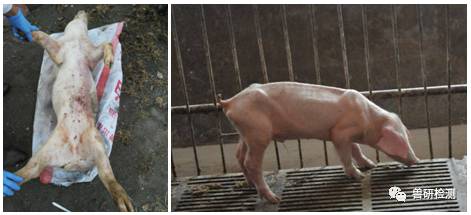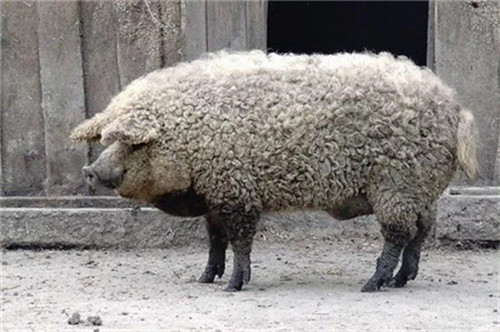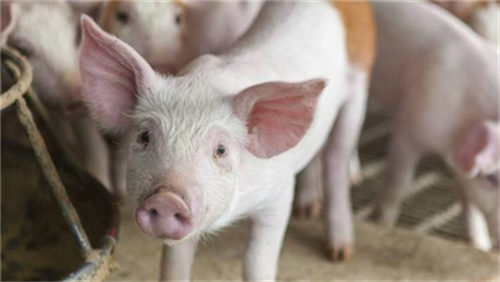Porcine circovirus disease and its detection case analysis
Porcine circovirus disease refers to a series of diseases with type 2 circovirus (PCV) as the main pathogen, single or secondary or mixed infection with other pathogenic microorganisms. It is the smallest animal virus found so far.
Porcine circovirus disease, also known as piglet multisystemic wasting syndrome (PMWS), is a kind of viral infectious disease characterized by physical decline, weight loss, diarrhea, dyspnea, immunosuppression and secondary infection of multiple pathogens.

I. pathogen
Porcine circovirus (PCV) is a member of the genus circovirus of the family circoviridae. It is the smallest animal virus with a particle diameter of 1425 nm, icosahedral symmetry and no envelope. The genome is a single strand of circular DNA virus.
At present, there are three known serotypes of PCV, that is, PCV1, PVC2 and PCV3,PCV1 are non-pathogenic viruses, and PCV2 is a pathogenic virus. It is the main pathogen of multisystemic wasting syndrome in weaned pigs. It generally begins to occur 2-3 days or 1 week after weaning. In acute pigs, the case fatality rate can reach 10%. The development of pigs after tolerance is obviously hindered, and PCV3 often causes cardiomyopathy and multi-system inflammation. PCV3 virus mainly attacks younger pigs after birth.
II. Popular characteristics
The disease can occur all the year round. Post-weaning multisystemic weakness syndrome (PMWS) mainly harms piglets 2-3 weeks after weaning, but in pig farms with early isolation of weaning, the disease also occurs in 10-14-day-old weaned piglets. The virus can be excreted with feces and nasal secretions, transmitted through the digestive tract, and may also be transmitted vertically through the placenta, with uncertain morbidity and mortality and endemic. The morbidity and mortality are low, but in acute outbreaks, the morbidity can reach 50% and the case fatality rate can reach 20% to 30%.
III. Clinical symptoms
It was mainly manifested in 6-Mel piglets of 8 weeks old. Before and after weaning, especially two weeks after weaning, skin lesions appeared in piglets, that is, a large number of red and purplish red spots appeared on the back, ear root and even abdomen, which generally protruded outward and had a hard texture. the proportion of stiff piglets in nursery piglets increased significantly, such as loss of appetite, weakness, weight loss, sometimes coughing or having central nervous system disorder until dyspnea. Jaundice, enlarged lymph nodes (palpable).
4. Anatomical symptoms
Autopsy showed enlarged systemic lymph nodes, especially inguinal, mediastinal, hilar, mesenteric and submandibular lymph nodes, with increased hardness and uniform white color, and some lymph nodes had bleeding and suppurative lesions. The lungs are swollen, hard or rubber-like, severe alveoli have hemorrhagic spots, some apical lobes and heart lobes atrophy or substantial lesions, liver darkening, atrophy, hepatic interlobular connective tissue hyperplasia, spleen abnormal swelling, fleshy changes, kidney edema, grayish white, sometimes white necrotic foci under the capsule, edema and non-hemorrhagic ulcers in the esophageal mucosa of the stomach, thinning of the intestinal wall of the ileum and colon Congestion and bleeding in the cecal and colonic mucosa.
5. Clinical diagnosis
Clinical diagnosis must be combined with clinical symptoms, pathological changes and laboratory detection of pathogens or antibodies in order to get reliable conclusions. ELISA and PCR monitoring methods are commonly used.
1.ELISA diagnostic method: it can be used to detect the level of virus antibody in serum. The immune level of circus vaccine in pig farm was monitored and a reasonable immunization procedure was established.
2.PCR method is a rapid, simple and specific diagnostic method. PCV-specific or group-specific primers were used to amplify the gene from the tissues of diseased pigs. According to the restriction map and base sequence of the amplified products, PCV infection was confirmed.
VI. Prevention and control measures
The persistent infection of 1.PCV2 makes the disease more destructive economically. The application of antibiotics and good management are helpful to solve the problem of concurrent infection.
two。 Strengthen feeding management, reduce feeding density, implement strict all-in-all-out system and mixed group system, reduce environmental stress factors, control concurrent infection, ensure stable immune status of pigs, strengthen biosafety measures inside and outside pig farms, and ensure that pigs come from clean pig farms when buying pigs are effective measures to prevent and control the disease and reduce economic losses.
3. Do a good job in pig farm hygiene, ventilation and disinfection.
In May 2017, the Central Peasant Veterinary testing Center received sick materials from farmers in Zhuozhou, Hebei Province. according to the description of the pig farm manager, the testing center carried out several laboratory testing projects, the specific contents and results are as follows:
1. Report information and test report number
two。 Detection items: classical swine fever, blue ear and ring three kinds of PCR detection, bacteria detection and drug sensitivity test in organs.
3. The results of PCR test showed that circular type 2 was positive and the others were negative.
Results of drug sensitivity test: as shown in the table below
4. Clinical suggestion: teacher Yin, an expert in the testing center, worked out a reasonable treatment plan according to the test results.
- Prev

4-day-old piglets have neurological symptoms, case sharing + prevention and treatment plan
4-day-old piglets have neurological symptoms, case sharing + prevention and treatment plan
- Next

Six emergency treatment methods for summer pig heatstroke, recommended collection!
Six emergency treatment methods for summer pig heatstroke, recommended collection!
Related
- On the eggshell is a badge full of pride. British Poultry Egg Market and Consumer observation
- British study: 72% of Britons are willing to buy native eggs raised by insects
- Guidelines for friendly egg production revised the increase of space in chicken sheds can not be forced to change feathers and lay eggs.
- Risk of delay in customs clearance Australia suspends lobster exports to China
- Pig semen-the Vector of virus Transmission (4)
- Pig semen-the Vector of virus Transmission (3)
- Five common causes of difficult control of classical swine fever in clinic and their countermeasures
- Foot-and-mouth disease is the most effective way to prevent it!
- PED is the number one killer of piglets and has to be guarded against in autumn and winter.
- What is "yellow fat pig"? Have you ever heard the pig collector talk about "yellow fat pig"?

